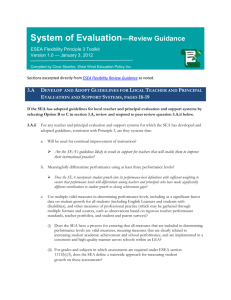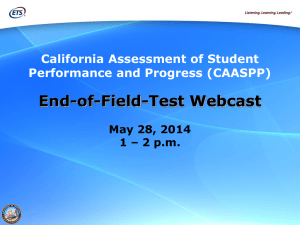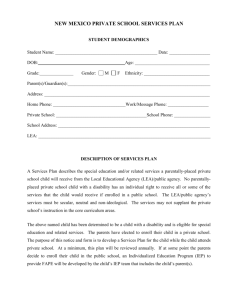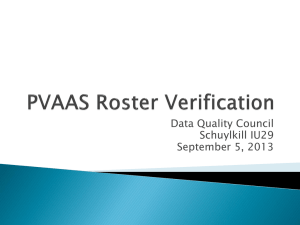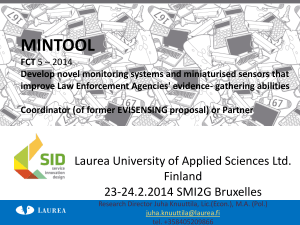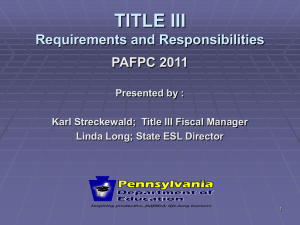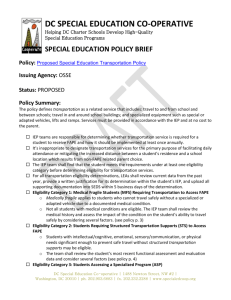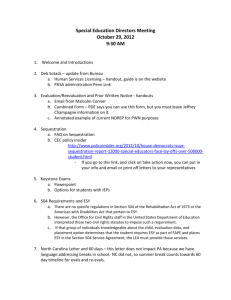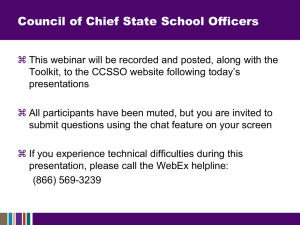Part B IDEA Tool Kit - Mississippi Department of Education
advertisement
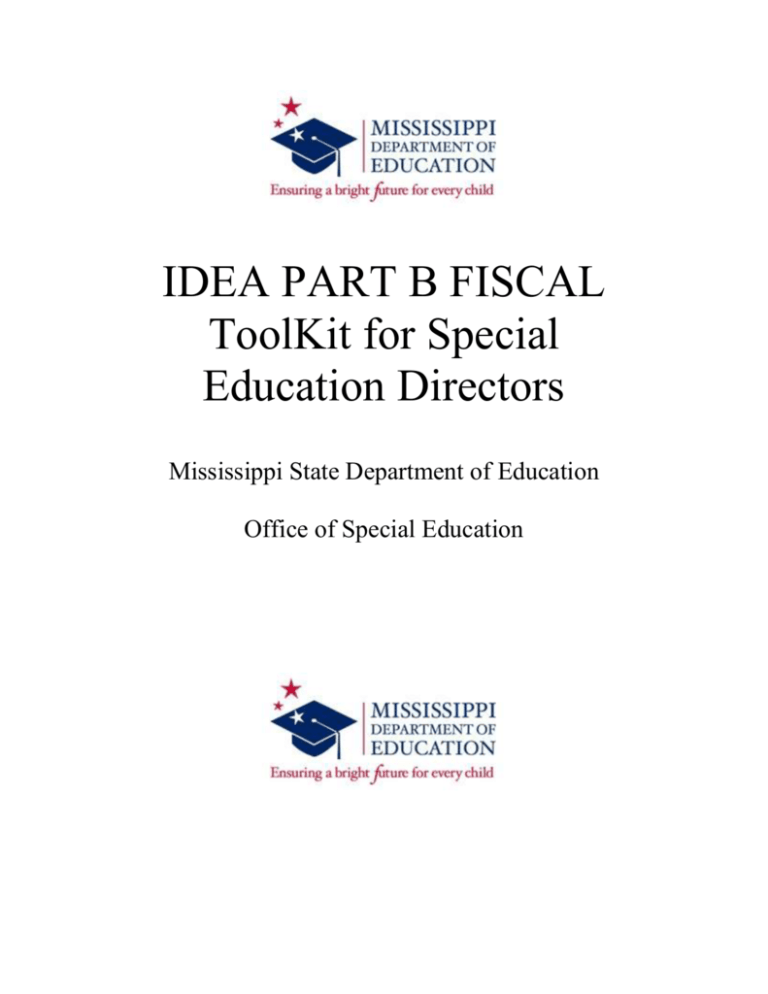
IDEA PART B FISCAL ToolKit for Special Education Directors Mississippi State Department of Education Office of Special Education Mississippi Department of Education IDEA Fiscal ToolKit _________________________________________________________________________________________________ Table of Contents SECTION ONE I. IDEA Fiscal Accountability Overview II. Glossary of Terms III. Allocations of IDEA funds to LEAs IV. Internal Controls V. Allowable Uses of IDEA Funds VI. Nonallowable Uses of IDEA Funds VII. Excess Cost Requirement VIII. Personnel Requirements Single Federal Award or Cost Objective Multiple Activities or Cost Objective Use of IDEA Funds for Nursing Positions Other (overtime; maternity leave; severance pay) IX. Indirect Cost Requirement X. Acquisition of Equipment XI. Leasing of Equipment XII. Fixed Assets/Inventory Requirements/Transfer of Equipment XIII. Contracting for Services XIV. Coordinated Early Intervening Services (CEIS) XV. Extended School Year Services (ESY) XVI. Proportionate Share of Funds for Parentally-Placed Private School Children with Disabilities XVII. Instructional Supplies Tuesday, February 16, 2016 Mississippi Department of Education IDEA Fiscal ToolKit _________________________________________________________________________________________________ XVIII. Maintenance of Effort Requirements and Exceptions XIX. Educable Child SECTION TWO REFERENCES: Food Directive Equipment Directive ESY Guidance Document Home Schooled Guidance Educational Interpreter Law Circular A87 Attachment B Timeline Calendar Chart Educable Child Procedures Project Application Preparation FORMS: Sample Semi-Annual Certification Forms Sample Time Distribution Sheet Form Sample Contract Form Written Procedures Outline Sample of Calculation of Indirect Cost Invoice Example (related service/professional development) USEFUL LINKS: OSEP: CEIS, private school/proportionate share Q & A, IDEA regulations OMB Circular A-87 Indirect cost calculation manual State Board Policies 7219 Office of the State Auditor Tuesday, February 16, 2016 Mississippi Department of Education IDEA Fiscal ToolKit _________________________________________________________________________________________________ SECTION ONE I. IDEA Fiscal Accountability Overview The Mississippi Department of Education, Office of Special Education (MDE/OSE) must ensure fiscal accountability for the use of IDEA Part B and Preschool funds. The MDE/OSE has established procedures for calculating, allocating, requesting, accessing, reporting, and verifying IDEA Part B flow-through funds. The purpose of this online IDEA Fiscal ToolKit is to provide local education agencies (LEAs) with an overview of required fiscal procedures, and to provide valuable guidance and tools for LEAs to use to ensure compliance with IDEA funding requirements. For those LEAs that do not currently have written fiscal procedures, this ToolKit will help to develop such procedures that will guide and ensure that appropriate use of IDEA funds are adhered to. II. Glossary of Terms and Acronyms CEIS – Coordinated Early Intervening Services CFR – Code of Federal Regulations EDGAR – Education Department General Administrative Regulations ESY – Extended School Year IDEA - Individuals with Disabilities Education Act LEA – Local Education Agency LRE – Least Restrictive Environment MDE – Mississippi Department of Education MOE –Maintenance of Effort ODHH – Office of Deaf and Hard of Hearing OSE – Office of Special Education OSEP – Office of Special Education and Programs RFP – Request for Proposal SEA – State Education Agency III. Allocations of IDEA funds to LEAs Each year Mississippi receives grant funding under Section 611 of the Individuals with Disabilities Education Act (IDEA). After setting aside necessary and allowable amounts for State administration and other State-level activities, the MDE/OSE must allocate the remainder of the grant as flow-through subawards to Mississippi LEAs. The funding formula is calculated on a combination of a base amount plus a percentage based on the total number of children enrolled in each jurisdiction, plus a percentage based on relative numbers of children living in poverty. The specifics of the funding formula are outlined in 34 CFR §300.705. It is very important that each LEA provide MDE/OSE with accurate child count data, school enrollment data, private school enrollment data, and free and reduced lunch count Tuesday, February 16, 2016 Mississippi Department of Education IDEA Fiscal ToolKit _________________________________________________________________________________________________ data. This will ensure that a fair and equitable distribution of the IDEA flow-through funds is determined each year. IV. Internal Controls LEAs must develop and maintain sound internal controls to ensure that all personnel, contractual services, and goods (equipment and instructional supplies) funded and purchased with IDEA subgrants are budgeted for and expended in accordance with the applicable provisions of IDEA and other Federal requirements. Internal controls must include an accounting system that focuses on accountability of how the funds are used (i.e. “fund accounting”). Accounting records must be supported by source documentation including: o o o o o Cancelled checks; Paid bills; Payrolls; Time and attendance records; and Contract and subgrant award documents. Fiscal controls and accounting procedures of each LEA must be sufficient to: (1) permit preparation of required reports; and (2) permit the tracing of funds to a level of expenditures adequate to establish that such funds have not been used in violation of the restrictions and prohibition of applicable statutes. Actual expenditures must be compared with budgeted amounts in State-approved grant applications. In addition, the financial management system in each LEA must be able to: o Prepare reports as required by EDGAR and IDEA; o Provide a complete disclosure of financial results (e.g. cash flow, expenditures, amendments); o Ensure that there is accountability in how IDEA funds are used; o Ensure that IDEA funds are not comingled with State funds and/or local funds; and o Ensure that IDEA funds are used to supplement and not supplant State, local, and other Federal funds. [34 CFR §§300.162(c), 300.202(a)(3)] LEAs are permitted to amend their IDEA grant within the approved direct cost budget to meet unanticipated needs and to make limited program changes. However, post-award changes to budgets and projects will require prior approval of MDE/OSE. In addition, LEAs must secure board approval to amendments. V. Allowable Uses of IDEA Funds In order to be allowable, LEAs must ensure that all costs incurred are necessary, reasonable, and allocable. [OMB Circular A-87; EDGAR 34 CFR §80.22] The following Tuesday, February 16, 2016 Mississippi Department of Education IDEA Fiscal ToolKit _________________________________________________________________________________________________ list illustrates allowable uses: 1. LEAs are permitted to use IDEA funds only to pay the excess costs of providing special education and related services to children with disabilities. [34 CFR §§300.16 & 300.202] 2. LEAs must ensure that costs incurred and funded through the IDEA grant are necessary, reasonable, and allocable. [OMB Circular A-87, EDGAR 34 CFR §80.22] 3. LEAs are permitted to use IDEA funds to pay for special education teachers, special education administrators, related service providers, instructional assistants, and secretarial support staff that directly provide services or support services to students with disabilities. 4. LEAs are permitted to use IDEA funds for special education staff to attend out of district or out-of-state meetings and conferences, only to the extent such costs are reasonable and necessary to accomplish the goals and objectives of the grant. The number of attendees and the approval process should be carefully considered and fully documented as related to the special education responsibilities of each potential attendee. In addition, costs for all conference attendance must be included in the LEAs grant application and receive prior approval from MDE/OSE. 5. LEAs are permitted to use IDEA funds for travel expenses only to the extent such costs are reasonable and necessary and do not exceed charges normally allowed by the LEA in its regular operations consistent with its written travel policies. LEAs should follow their own travel and per diem rules and costs when charging travel expenses to their IDEA grant. 6. LEAs are permitted to use IDEA funds to purchase instructional materials to be used by special education teachers and related service providers to meet the unique educational needs of children with disabilities. (see section below) 7. LEAs are permitted to use IDEA funds to purchase, lease, or otherwise provide for the acquisition of assistive technology devices to maintain or improve the functional capabilities of children with disabilities. 8. LEAs are permitted to purchase food ONLY as those purchases directly relate to instructional activities involving food shopping and preparation. Food purchases and activities must be supported by teacher lesson plans and be necessary to meet student IEPs related to independent living goals and objectives. 9. LEAs are permitted to contract for services only if (1) there is a written contract specifying the terms of the vendors’ services; (2) the contract providers are Tuesday, February 16, 2016 Mississippi Department of Education IDEA Fiscal ToolKit _________________________________________________________________________________________________ appropriately licensed; (3) the fees are determined to be reasonable and customary for the provision of such services in the area; (4) the LEA has determined that the services cannot be provided by district employees; and (5) the LEA has internal controls in place to verify the delivery of contracted services as specified in contracts and on submitted invoices. [OMB CIRCULAR A-87, ATTACHMENT A] VI. Non-Allowable Uses of IDEA Funds There are numerous non-allowable uses of Federal funds, including IDEA grant funds. The MDE/OSE may seek to recover any Federal funds identified, in an audit or through onsite monitoring, as having been used for unallowable costs. If MDE/OSE determines that an LEA must return funds, those funds cannot be returned out of Federal funds. [34 CFR §300.202] The following is a list of specific non-allowable expenses. However, the list is not exhaustive. Any questions related to the allowability of IDEA fund use that is not included below should be directed to MDE/OSE. 1. IDEA funds may not be used to pay attorneys' fees or costs of a party related to any action or proceeding under section 615 of the Act, (including attendance at IEP meetings, due process hearings, appeals of due process hearings to Federal court, court recordings). [34 CFR §300.517(b)] 2. IDEA funds may not be used to pay any person for influencing, or attempting to influence: o o o o An officer or employee of any agency; A member of Congress; An officer or employee of Congress; or An employee of a member of Congress. 3. IDEA funds may not be used to influence the awarding of, or the extension, continuation, renewal, amendment, or modification of any contract or cooperative agreement. 4. IDEA funds may not be used to reduce the level of expenditures for the education of children with disabilities made by the LEA from local funds below the level of those expenditures for the preceding fiscal year. [34 CFR §§300.203] (see maintenance of effort section below) 5. IDEA funds may not be used to purchase food or beverages for meetings, staff development activities, parent training activities, student meals, or classroom snacks [see MDE MEMO dated November 12, 2012]. Tuesday, February 16, 2016 Mississippi Department of Education IDEA Fiscal ToolKit _________________________________________________________________________________________________ 6. IDEA funds may not be used to support activities under Section 504, including allocation of staff time, purchase of materials, or in support of direct services to non-special education students. 7. IDEA funds may not be used to pay for entertainment, including costs for amusement, diversion, or social activities. 8. IDEA funds may not be used to purchase gifts, gift cards, pre-paid cards, or awards for staff or students. 9. IDEA funds may not be used to purchase or support the use of computer networks and servers, or cell phones. 10. IDEA funds may not be used to pay for students to participate in SAT or ACT college entrance exams, or for preparatory classes related to these exams. 11. IDEA funds may not be used to pay for students with disabilities to participate in regular summer school programs. 12. IDEA funds may not be used to pay for contracted employees’ continuing education classes and/or conferences related to securing or maintaining their certification. 13. IDEA funds may not be used to pay for student medications, or for medical devices that are surgically implanted. 14. IDEA funds may not be used to pay for office or classroom furniture unless specifically authorized by MDE and included in the grant application. VII. Excess Cost Requirement Excess costs are those costs associated with the education of an elementary school or secondary school student with a disability that are in excess of the average annual per student expenditure in an LEA during the preceding school year for ALL elementary school or secondary school students. [34 CFR 300.202(b)] An LEA must spend at least the average annual per student expenditure on the education of an elementary school or secondary school child with a disability before funds under Part B of the Act are used to pay the excess costs of providing special education and related services. That amount may not include capital outlay or debt service. For a particular cost to be allowable, it must be an excess cost of providing special education and related services. Only allowable costs may be charged to IDEA Part B or Preschool grants. In addition, in order for the cost to be allowable, it must be necessary and reasonable for proper and efficient performance and administration of the grant. A cost is reasonable if it does not exceed what a district would normally incur in the Tuesday, February 16, 2016 Mississippi Department of Education IDEA Fiscal ToolKit _________________________________________________________________________________________________ absence of Federal funds. IDEA’s excess cost requirement prevents an LEA from using Part B funds to pay ALL of the costs directly attributable to the education of children with disabilities, with the following exception: The regulations in IDEA §300.202(b) permit an LEA to use Part B funds to pay for all of the costs directly attributable to the education of a child with a disability in the age ranges of 3-5 and 18-21, only if no local or State funds are available to provide for the education of children WITHOUT disabilities of those same age ranges. In such cases, the LEA must comply with the non-supplanting and other requirements of Part B in providing the education and services for these children. When determining whether a cost is an excess cost, ask the following guiding questions: 1. In the absence of special education needs, would this cost exist? a) No, then the cost is an excess cost and may be eligible. b) Yes, then the cost is not an excess cost and is not allowed. 2. Is this cost also generated by students without disabilities? a) No, then the cost is an excess cost and may be eligible. b) Yes, then the cost is not an excess cost and is not allowed. 3. If it is a child-specific service, is the service documented in the student’s IEP? a) Yes, then the cost is an excess cost and may be eligible. b) No, then the cost is not an excess cost and is not allowed. VIII. Personnel Requirements For IDEA, Part B, personnel must be utilized in accordance with the applicable provisions of Part 300. Time distribution documentation for all Federally-funded employees is a standard requirement for payroll activity and personnel activity reports. Fringe benefits are an allowable expense if the following conditions exist: o They are provided under established written policies; o The costs are equitably allocated to all related activities, including Federal awards; and o The accounting basis (cash or accrual) selected for costing each type of leave is consistently followed by the governmental unit. Employees can either be fully funded using IDEA grant funds or partially funded using a combination of Federal and local or State funds. Both options, and the specific requirements for each, are described below. Tuesday, February 16, 2016 Mississippi Department of Education IDEA Fiscal ToolKit _________________________________________________________________________________________________ Single Federal Award or Cost Objective Most LEAs use a portion of their IDEA grant funds to pay 100 percent of the salaries and employee benefits for some of their special education staff. In this case, when employees are expected to work solely on a single Federal award or cost objective, a periodic certification for each of these employees must be made supporting their salaries and wages. This documentation must show that the employee worked solely on IDEA activities for the period of the certification. The required certifications must: o Be prepared at least semi-annually; and o Be signed by the employee; or o A supervisory official having firsthand knowledge of the work performed by the employee. [Circular A-87 Attachment B (8) (h1-3); 34 CFR §300.202(a)] A sample semi-annual certification form is included in the Appendices under Section Two. Multiple Activities or Cost Objective Some LEAs use their IDEA grant funds to pay a portion or percentage of the salaries and employee benefits for some of their special education staff. In this case, when employees work on multiple activities or cost objectives, a distribution of their salaries or wages must be supported by personnel activity reports (PAR) or equivalent documentation that meets the following standards: o They must reflect an after-the-fact distribution of the actual activity of each employee, in accordance with their job description; o They must account for the total activity for which each employee is compensated; o They must be prepared at least monthly and must coincide with one or more pay periods; and o They must be signed and dated by the employee and the employee’s immediate supervisor. LEAs often refer to these employees as split-funded. An example of a split-funded employee could be a special education director that is 50 percent funded from the IDEA grant and 50 percent funded from district funds. The special education director performs special education duties 50 percent of the time and performs district test coordinator duties for the 50 percent funded from district funds. All positions funded partially from IDEA funds and partially from non-IDEA funds must be included in the LEAs’ approved budget. In addition, employee benefits for split-funded staff must be prorated based on Tuesday, February 16, 2016 Mississippi Department of Education IDEA Fiscal ToolKit _________________________________________________________________________________________________ the funding ratio. The LEA must be able to verify that benefits are charged to the appropriate funding source for those salaries paid with multiple funding sources. [Circular A-87 Attachment B-8(h4-6)] Extreme caution must be adhered to by all LEAs when deciding to split-fund employees to avoid supplanting. LEAs must be able to demonstrate that it would not have provided a service in question with IDEA funds had those funds not been available. A sample time distribution (time sheet) form is included in the Appendices under Section Two. Use of IDEA Funds for Nursing Positions Some LEAs seek approval to use IDEA funds for salary and employee benefits for Licensed Registered Nurses. In order to be an allowable use of IDEA grant funds, the nursing responsibilities must be IEP-driven or related to the evaluation of children. [34 CFR §300.34 (c) (13)] The day-to-day cost of providing general nursing services in a school is not allowed for IDEA grant-funded nursing positions. Only the actual time providing related services as required by IEPs or performing evaluations is allowed. Nursing positions must be fully justified in yearly IDEA grant applications, and must specify whether or not the nurse has only special education responsibilities or also includes non-special education duties. In addition, if a nurse is split-funded, documentation of efforts and activities must be reflected on time distribution sheets and personnel activity reports as required for all split-funded employees. There is more information related to Time and Effort Reporting Requirements in Section Two. IX. Indirect Cost Requirement The MDE/OSE calculates each LEA’s indirect cost rate for each grant year. When preparing their grant applications, LEAs’ indirect cost amount must not exceed the percentage allowed in the State’s calculation. “Indirect costs are those: (a) incurred for a common or joint purpose benefiting more than one cost objective; and (b) not readily assignable to the cost objectives specifically benefitted without effort disproportionate to the results achieved.” [OMB Circular A-87 Attachment A] A cost may not be allocated to a Federal award as an indirect cost if any other cost incurred for the same purpose, in like circumstances, has been assigned to a Federal award as a direct cost. Typical indirect costs include: Rented or shared space or facility. Payment of proportionate amount for utilities. Tuesday, February 16, 2016 Mississippi Department of Education IDEA Fiscal ToolKit _________________________________________________________________________________________________ Payment for proportionate share for services. Distribution of cost pool so as to produce equitable results. In addition, accounting, auditing, payroll, personnel, budgeting, purchasing, and operation and maintenance of plant facilities are all examples of services which typically benefit several activities and programs, and for which appropriate costs may be attributed to IDEA by means of the indirect cost allocation plan [EDGAR §76.560-76.579 and Circular A-87, Attachment A]. Indirect costs charged to the grant are determined by applying the restricted indirect cost rate (RICR) to total direct costs of the grant minus capital outlays, subgrants, and other distorting or unallowable items as specified in the grantee’s indirect cost rate agreement. Although, districts should calculate what their maximum indirect cost each year could be based on the full amount of their grant award, the final calculation should be based only on the amount of the expenditures incurred each year. The transfer of the indirect costs should occur on or after the expenditures have occurred. There is more information related to indirect cost calculations under Section Two. X. Acquisition of Equipment LEAs may purchase equipment with IDEA funds providing they receive prior approval from MDE/OSE. Equipment is defined as an article of nonexpendable, tangible personal property having a useful life of more than one year and an acquisition cost that exceeds $5,000 per unit. In addition, “highly walkable” items with a useful life of one year or more, and having an acquisition cost of $500 or more per unit, are considered to be “equipment”. Highly walkable items include, but are not limited, to laptops, iPads, audio-visual equipment, DVD players, think-pads, cameras, etc. Equipment purchased with Federal funds shall be used for the program or project for which it was acquired as long as needed, whether or not the project or program continues to be supported by Federal funds. [OMB Circular A-87 Attachment B (15)] All equipment purchased using IDEA Part B funds must be used in accordance with the applicable provisions of Part 300. An official memo was issued to LEAs from MDE/OSE on September 6, 2013 related to the purchase of equipment. XI. Leasing of Equipment Where appropriate, LEAs are permitted to use IDEA funds to lease equipment in support of their special education programs. LEAs must carefully evaluate decisions related to lease verses purchase alternatives in order to determine the most economical approach. Tuesday, February 16, 2016 Mississippi Department of Education IDEA Fiscal ToolKit _________________________________________________________________________________________________ Allowability of leases is based upon: o Leasing costs of comparable equipment; o Alternatives available; and o The type, life expectancy, condition, and value of the equipment leased. All leases must be entered into by way of a written contract that specifies the terms and conditions of the lease. Lease contracts must be reviewed periodically to determine if needs or circumstances have changed, and if other options are determined available. For IDEA, Part B, leases must be in accordance with the applicable provisions of Part 300. XII. Fixed Assets/Inventory Requirements All property procured through the use of IDEA, Part B funds must be used in accordance with the applicable provisions of Part 300. A physical inventory of the property must be taken and the results reconciled with the property records at least once every two years. Property records must contain information set forth in EDGAR §80.32(d)(1), which includes: o o o o o o o o A description of the property, a serial number or other identification number; The source of property; Who holds title; The acquisition date; Cost of the property; Percentage of Federal participation in the cost of the property; The location, use and condition of the property; and Any ultimate disposition data including the date of disposal and sale price of the property. Each LEA must develop and utilize adequate maintenance procedures to keep property in good working condition. In addition, a control system should be in place to ensure adequate safeguards to prevent loss, damage, or theft of the property. Any loss, damage, or theft must be investigated and the results documented. LEAs must maintain control of, hold title to, and administer equipment and property purchased with IDEA funds that are used to provide services to children in private schools [34 CFR §300.144(a)]. XIII. Contracting for Services Contracts funded using IDEA, Part B funds must be for services, materials, supplies or other items to be provided in accordance with the applicable requirements of Part 300. In addition, EDGAR §80.36 lists 13 contract provisions, which may need to be included in contracts that are awarded by LEAs that use Federal funds. Tuesday, February 16, 2016 Mississippi Department of Education IDEA Fiscal ToolKit _________________________________________________________________________________________________ Mandatory contract provisions include: o o o o o Reporting requirements; Patent rights; Copyrights; Ability to examine records of the contractor; and Record retention requirements. Other contract terms may need to be included depending on the type of contract. LEAs shall not contract with parties that have been debarred or suspended under Executive Order 12549. Information on the Excluded Parties List System may be found at https://www.sam.gov/. In addition, all contracts must be for a period of no more than one year, and must include a termination clause. LEAs are expected to have procedures in effect to ensure that contractors meet the terms of their agreements, and must maintain documented internal controls to this effect. LEAs must use careful judgment when determining whether to employ staff to provide related and support services out of IDEA grant funds or to secure services through contracting. According to EDGAR §75.515(b), “the grantee may not use its grant to pay a consultant unless (1) there is a need for the services of that consultant; and (2) the grantee cannot meet that need by using an employee rather than a consultant.” In addition, the cost of contracting for services must be reasonable, and defendable to auditors. According to OMB Circular A-87, Attachment A(C)(1) “To be allowable under Federal awards, costs must be necessary and reasonable for proper and efficient performance and administration of Federal awards.” A cost is reasonable if, in its nature and amount, it does not exceed that which would be incurred by a prudent person under the circumstances prevailing at the time the decision was made to incur the cost. A sample contract form is included in Section Two of the ToolKit. XIV. Coordinated Early Intervening Services (CEIS) An LEA may voluntarily set aside up to 15 percent of its IDEA sub-award for CEIS activities. See Appendix D of the IDEA regulations for examples when LEAs set aside 15 percent of funds for CEIS. If an LEA voluntarily sets aside 15 percent of its IDEA award for CEIS, OR is required to set aside 15 percent of its IDEA sub-award due to a finding of significant disproportionality, it may not adjust its fiscal effort under §300.205. Appendix D of the IDEA regulations provides examples of how CEIS and adjustments to fiscal effort interact with each other. [34 CFR §§300.226 and 300.208(a) (2)] If LEAs utilize IDEA funds for staffing positions related to CEIS, extreme caution must be taken to avoid supplanting. An example of this would be a Social Worker or Behavior Specialist position that was 100 percent district funded in a previous school year, and then split 50-50 percent district and IDEA funding in the current year, with 50 percent of Tuesday, February 16, 2016 Mississippi Department of Education IDEA Fiscal ToolKit _________________________________________________________________________________________________ the employee’s time devoted to CEIS activities. Unless in that year, the LEA also hired a new Social Worker (not CEIS) or Behavior Specialist (not CEIS) that was paid out of district (non-IDEA) funds for at least 50 percent of his/her salary, there could very well be a supplanting issue. XV. Extended School Year Services (ESY) Extended school year is the provision of special education and related services to students with disabilities in accordance with their Individualized Education Program (IEP) beyond the normal school year of the local district and at no cost to the parents of the students. [34 CFR §300.106] Eligibility for ESY must be determined each year for every child that has a current IEP. LEAs are required to submit an ESY budget application and receive approval from MDE/OSE in order to be reimbursed for ESY expenses. Students with disabilities who turn age twenty-one (21) during the school year and who are eligible for ESY services may be served in an ESY program as determined by the IEP committee. The continued placement of students in a private facility must be based on the need for ESY services. Placement of students in a private facility only for ESY services requires a Letter of Justification. XVI. Proportionate Share of Funds for Parentally-Placed Private School Children with Disabilities IDEA requires LEA’s have in place policies and procedures to ensure that they locate, identify, and evaluate all children with disabilities who are enrolled by their parents in private schools located within the LEA. Such schools include religious, elementary and secondary schools that meet the State’s definition of elementary school or secondary school. A proportionate share of the LEAs IDEA Part B and Preschool funds is then determined by formula and set aside for the purpose of providing services to those private school children. IDEA 34 CFR §§300.129-144 sets forth the requirement of LEAs to serve children with disabilities who are parentally placed in private schools. The calculation of the proportionate share for each year is based on the annual count of the number of parentally-placed private school children with disabilities that was conducted in the previous year and reported in the IDEA Part B and Preschool application for the current year. LEAs must use their proportionate share funds to pay for services provided to parentallyplaced private school children. Tuesday, February 16, 2016 Mississippi Department of Education IDEA Fiscal ToolKit _________________________________________________________________________________________________ XVII. Instructional Supplies and Materials IDEA funds may be used to purchase instructional supplies and materials that are utilized by special education teachers and support services personnel to support and/or provide instruction to students with disabilities. Specific items of supplies and materials that can be included are included as object codes in the IDEA grant applications. This is an area of confusion for some districts and must be given careful consideration before purchasing and/or coding to “instructional supplies” from the IDEA grant funds. During fiscal monitoring visits, MDE has discovered that some LEAs purchase items that are either not budgeted for, or were incorrectly coded to this category. The following chart provides examples of items that can or cannot be considered instructional supplies: Considered Instructional Supplies Consumable classroom supplies are ones that used up or transformed in their use. They are generally not used for more than one year. Educational supplies and curriculum related materials directly involved with implementing IEPs Computer software Technology for class management Workbooks for student instructional use Copier paper Food purchases directly related to instructional activities involving food shopping and preparation; supported by teacher lesson plans; and necessary to meet student IEP objectives related to independent living skills. Test protocols and booklets to access student’s progress. NOT Considered Instructional Supplies Office furniture (tables, chairs, credenzas, hutches etc) Small electronics (Nooks, iPads, other tablets, printers, microwaves, vacuum cleaners, refrigerators) Food and beverages purchased for professional development activities, parent meetings, staff meetings, or classroom lunches/snacks Cameras; Assistive technology devices; Desktop or laptop computers; Medical supplies (rubber gloves, catheters, bandages XVIII. Maintenance of Effort Requirements and Exceptions IDEA 34 CFR §300.203 sets forth the requirement that funds provided to an LEA under Part B of the Act must not be used to reduce the level of expenditures for the education of Tuesday, February 16, 2016 Mississippi Department of Education IDEA Fiscal ToolKit _________________________________________________________________________________________________ children with disabilities made by the LEA from local funds below the level of those expenditures for the preceding fiscal year. Exceptions: 1. The calculations (utilizing the FETS data transmitted to the MDE) are incorrect. 2. The voluntary departure, by retirement or otherwise, or departure for just cause, of special education or related services personnel, who were replaced by qualified, lower-salaried staff. 3. There was a decrease in enrollment of children with disabilities, which resulted in a reduction of teacher units needed to serve students with disabilities. 4. An exceptionally costly special education program provided to a particular disabled child utilizing State and/or local funds was terminated. 5. Costly expenditures for long-term purchases, such as the acquisition of equipment or the construction of school facilities, were terminated. XIX. Educable Child Per State Board Policy 7201, the Mississippi Department of Education (MDE), Office of Special Education (OSE) is directed to provide oversight through the Individuals with Disabilities Education Act (IDEA) and State Statute in the placement and funding of students with disabilities in private school/facilities. All private schools/facilities participating in the Educable Child Program are accredited by a state or regional accrediting agency. State appropriated funds are used to pay the total cost for the required placement as defined by the State Legislature and as State funds are available. Students who participate in the Educable Child Program fall into one of the four placement categories: School District; Department of Human Services; Parent or Parent with Medicaid. All placement applications are reviewed and approved for payment by a State Level Review Board. Tuesday, February 16, 2016 Mississippi Department of Education IDEA Fiscal ToolKit _________________________________________________________________________________________________ SECTION TWO - REFERENCES AND SAMPLE FORMS References: 1. “Food Memo” 2. “Equipment Memo” 3. ESY Handbook 4. “Home Schooled Memo” 5. Educational Interpreter Law http://www.odhh.org/images/user_files/files/sb2715sg.pdf 6. Educable Child Procedures Sample Forms: Semi-Annual Certification Forms Time Distribution Sheet/Form Contract Form Calculation of Indirect Cost http://www.mde.k12.ms.us/OSFS/IC Sample of written fiscal procedures outline Useful links: OSEP http://www2.ed.gov/about/offices/list/osers/osep/index.html CEIS http://idea.ed.gov/explore/view/p/%2Croot%2Cdynamic%2CQaCorner%2C8%2C Private school/proportionate share Q & A http://idea.ed.gov/explore/view/p/%2Croot%2Cdynamic%2CQaCorner%2C1%2C IDEA regulations http://www.mde.k12.ms.us/OSE/PP OMB Circular A-87 http://www.mde.k12.ms.us/OSE/funding State Board Policies 7219 http://www.mde.k12.ms.us/MBE/manual/policy-7200-special-education/policy-7219individuals-with-disabilities-education-improvement-act Office of the State Auditor Mississippi Office of the State Auditor Tuesday, February 16, 2016
